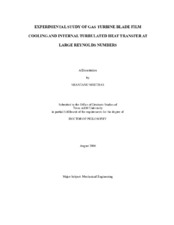| dc.contributor.advisor | Han, Je-Chin | |
| dc.creator | Mhetras, Shantanu | |
| dc.date.accessioned | 2010-01-15T00:15:15Z | |
| dc.date.accessioned | 2010-01-16T02:13:57Z | |
| dc.date.available | 2010-01-15T00:15:15Z | |
| dc.date.available | 2010-01-16T02:13:57Z | |
| dc.date.created | 2006-08 | |
| dc.date.issued | 2009-06-02 | |
| dc.identifier.uri | https://hdl.handle.net/1969.1/ETD-TAMU-1820 | |
| dc.description.abstract | Film cooling effectiveness on a gas turbine blade tip on the near tip pressure side and on the
squealer cavity floor is investigated. Optimal arrangement of film cooling holes, effect of a full
squealer and a cutback squealer, varying blowing ratios and squealer cavity depth are also
examined on film cooling effectiveness. The film-cooling effectiveness distributions are
measured on the blade tip, near tip pressure side and the inner pressure and suction side rim
walls using a Pressure Sensitive Paint (PSP) technique. A blowing ratio of 1.0 is found to give
best results on the pressure side whereas the other tip surfaces give best results for blowing ratios
of 2. Film cooling effectiveness tests are also performed on the span of a fully-cooled high
pressure turbine blade in a 5 bladed linear cascade using the PSP technique. Film cooling
effectiveness over the entire blade region is determined from full coverage film cooling,
showerhead cooling and from each individual row with and without an upstream wake. The
effect of superposition of film cooling effectiveness from each individual row is then compared
with full coverage film cooling. Results show that an upstream wake can result in lower film
cooling effectiveness on the blade. Effectiveness magnitudes from superposition of effectiveness
data from individual rows are comparable with that from full coverage film cooling.
Internal heat transfer measurements are also performed in a high aspect ratio channel and
from jet array impingement on a turbulated target wall at large Reynolds numbers. For the
channel, three dimple and one discrete rib configurations are tested on one of the wide walls for
Reynolds numbers up to 1.3 million. The presence of a turbulated wall and its effect on heat
transfer enhancement against a smooth surface is investigated. Heat transfer enhancement is
found to decrease at high Re with the discrete rib configurations providing the best enhancement
but highest pressure losses. Experiments to investigate heat transfer and pressure loss from jet array impingement are also performed on the target wall at Reynolds numbers up to 450,000.
The heat transfer from a turbulated target wall and two jet plates is investigated. A target wall
with short pins provides the best heat transfer with the dimpled target wall giving the lowest heat
transfer among the three geometries studied. | en |
| dc.format.medium | electronic | en |
| dc.format.mimetype | application/pdf | |
| dc.language.iso | en_US | |
| dc.subject | heat transfer | en |
| dc.subject | film cooling | en |
| dc.subject | gas turbines | en |
| dc.subject | tip | en |
| dc.subject | channel | en |
| dc.subject | impingement | en |
| dc.subject | dimples | en |
| dc.subject | ribs | en |
| dc.title | Experimental study of gas turbine blade film cooling and internal turbulated heat transfer at large Reynolds numbers | en |
| dc.type | Book | en |
| dc.type | Thesis | en |
| thesis.degree.department | Mechanical Engineering | en |
| thesis.degree.discipline | Mechanical Engineering | en |
| thesis.degree.grantor | Texas A&M University | en |
| thesis.degree.name | Doctor of Philosophy | en |
| thesis.degree.level | Doctoral | en |
| dc.contributor.committeeMember | Chen, Hamn-Ching | |
| dc.contributor.committeeMember | Lau, S. C. | |
| dc.contributor.committeeMember | Morrison, Gerald | |
| dc.type.genre | Electronic Dissertation | en |
| dc.type.material | text | en |
| dc.format.digitalOrigin | born digital | en |


